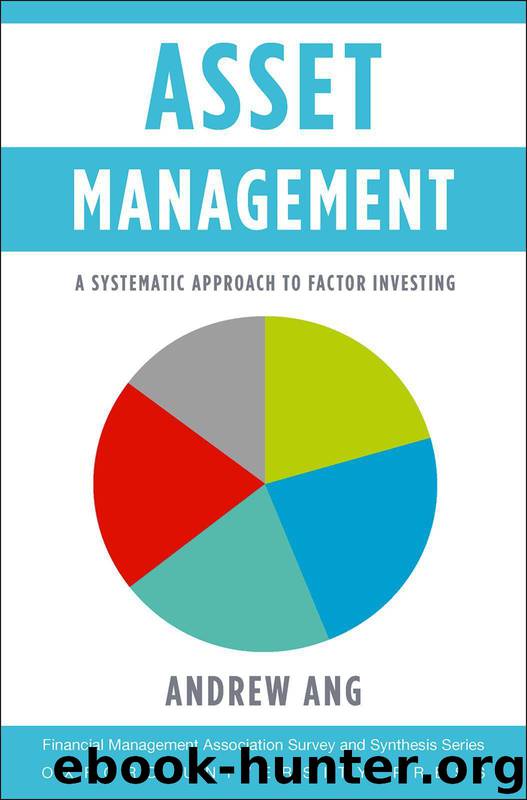Asset Management: A Systematic Approach to Factor Investing (Financial Management Association Survey and Synthesis Series) by Andrew Ang

Author:Andrew Ang
Language: eng
Format: mobi
Publisher: Oxford University Press
Published: 2014-07-06T16:00:00+00:00
Fiduciaries (NCREIF), which collects property data from its members. NCREIF
computes a value-weighted index based on appraisals on a quarterly basis. The
indirect property returns are the FTSE NAREIT All Equity returns, also at the
quarterly frequency. I compare these property returns with S&P 500 equity returns.
Table 11.11 shows that NCREIF returns are very smooth (the quarterly
autocorrelation is 78% and volatility is just 2.2%) compared to REIT and equity
returns, which have autocorrelations close to zero and volatilities around 8% to
9%. Notably, the correlation between REIT and equity returns is high, at 63%,
while the correlation between NCREIF and REIT returns is low, at 15%. Thus
REITs resemble equities more than they resemble direct real estate. Hartzell and
Mengden, who were industry practitioners at Salomon Brothers, were the first to
document this phenomenon in 1986, and they generated substantial discussion about
the underlying nature of real estate returns. Was real estate indeed a separate asset
class, or was it just a different version of equity (and debt)?
This debate continues in real estate economics today. My takeaways for asset
owners from this long literature are:
Direct Real Estate Returns Are Not Returns
The NCREIF series (and the corresponding widely used Investment Property
Databank series in Europe) have many data biases because the values are not based
on market transactions. REIT returns, in contrast, are investable returns. There are
two important and large biases:33
1. Smoothing bias
Using appraisals (done at most once or twice a year) artificially induces
smoothness,34 which is why the autocorrelation of the NCREIF series is so much
439
higher than REITs or equities in Table 11.11.
2. Selection bias
The properties that you see sold are not representative of the entire stock. For
example, perhaps only the best properties are sold because those are the ones a
developer is sprucing up, while the foreclosed crummy ones are not being sold. 35
In addition, REITs are levered while NCREIF returns are reported on an
unlevered basis. Researchers have developed many methods to move from
appraisals to transaction-level (and repeat-sales) indices, to desmooth real estate
returns, to take into account selection bias, and to remove other illiquidity biases.
The effects of these biases are enormous. Lin and Vandell (2012), for example,
report that for a one-year holding period, the variance of direct real estate returns
should be three times higher than the raw variance reported in Table 11.11.
Pagliari, Scherer, and Monopoli (2005) argue that there is no difference in direct
and indirect real estate returns after adjusting for leverage and sector composition
and also adjusting direct real estate returns for appraisal smoothing.
Smoothing and selection biases are shared by all illiquid assets—including
private equity—and I discuss methods of dealing with them in chapter 13. I use
NCREIF returns for now, but you’ve been warned: these are not actual returns.
In the Long Run, Direct and Indirect Real Estate Returns Move Together
Direct and indirect real estate returns are linked in the long run. Figure 11.12
graphs the correlation of long-horizon log NCREIF returns with long-horizon log
REIT returns. At the one-quarter horizon, the correlation is around 0.22, which
reflects the low correlation between NCREIF and REIT returns in Table 11.11.
(Quarterly returns in Table 11.11 are arithmetic returns but I use log returns in
Figure 11.
Download
This site does not store any files on its server. We only index and link to content provided by other sites. Please contact the content providers to delete copyright contents if any and email us, we'll remove relevant links or contents immediately.
Hit Refresh by Satya Nadella(8325)
The Compound Effect by Darren Hardy(7540)
Change Your Questions, Change Your Life by Marilee Adams(6632)
Nudge - Improving Decisions about Health, Wealth, and Happiness by Thaler Sunstein(6627)
The Black Swan by Nassim Nicholas Taleb(6179)
Daring Greatly by Brene Brown(5633)
Deep Work by Cal Newport(5446)
Principles: Life and Work by Ray Dalio(5313)
Rich Dad Poor Dad by Robert T. Kiyosaki(5138)
The Myth of the Strong Leader by Archie Brown(4783)
Man-made Catastrophes and Risk Information Concealment by Dmitry Chernov & Didier Sornette(4723)
Big Magic: Creative Living Beyond Fear by Elizabeth Gilbert(4714)
The Slight Edge by Jeff Olson(4712)
Discipline Equals Freedom by Jocko Willink(4627)
The Motivation Myth by Jeff Haden(4519)
Digital Minimalism by Cal Newport;(4501)
Stone's Rules by Roger Stone(4409)
Management Strategies for the Cloud Revolution: How Cloud Computing Is Transforming Business and Why You Can't Afford to Be Left Behind by Charles Babcock(4126)
The Doodle Revolution by Sunni Brown(4031)
